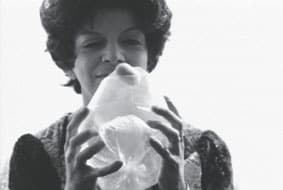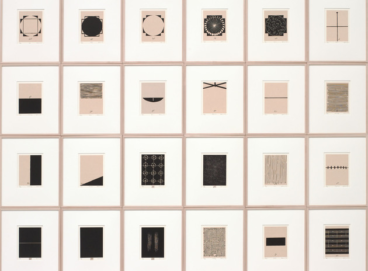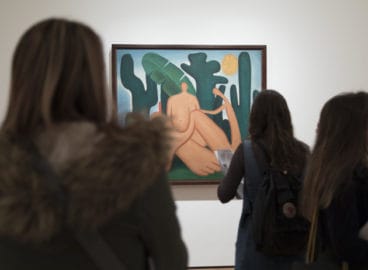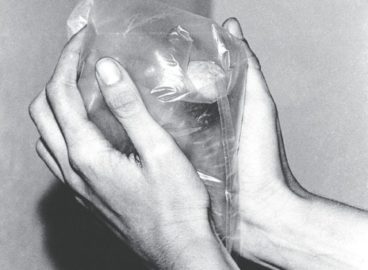Through Brazilian musician Caetano Veloso to ancient Roman philosopher Pliny the Elder, scholar Luis Pérez-Oramas outlines and contextualizes Brazilian artist Lygia Clark’s vast body of work. Part two of this essay positions Clark’s paintings as architectural explorations and living organisms.
In addition to the essay by Pérez-Oramas, you can access installation views and the press release through MoMA’s online exhibition history archive here.

It seems important, then, to clarify the myth of origins indexed by many modernist narratives, even as they translate that myth into the terms of a supposed liberation of painting into the third dimension. A number of questions emerge here, relating to the relevance of that originary myth to our understanding of modernist abstraction and of the subversions it supposedly practiced, and in particular to Clark’s critical inscription within it: why, in the twentieth century, was painting so often the chosen field of this supposedly emancipatory adventure? Why did abstraction establish its principles, possibilities, and theoretical positions through painting more than anywhere else? And insofar as we can continue to use the word “emancipation”— about which reservations abound—why would painting need to emancipate itself, and from what? Looking at Clark’s art of the 1960s—the Abrigos poéticos, theBichos, the Objetos sensoriais (Sensorial objects, 1966), the Máscaras sensoriais(Sensorial masks, 1967) and Máscaras abismos (Abyssal masks, 1968), theArquiteturas biológicas (Biological architectures, 1968), the Estructuras vivas (Living structures, 1969)—we should also ask: if Gullar’s narrative holds, what does it mean for these objects that they were once “paintings”? What role does a prehistory in painting play in these objects that are no longer paintings? What beyond their own “emancipation” might be implied by their incarnating and enacting a sort of oblivion of painting? What does it mean, in the end, for Clark’s work to have once been painting?
If this doesn’t seem sophistic, or too abrupt a recourse to authority, I’d here like to make the point that at least since Aristotle, being has been defined in terms of having been. It can only be predicated in terms of the perfect preterite or past anterior tense. Aristotle expresses quidditas—what each thing is for itself—with an enigmatic formulation that has complicated the world of things and of their knowledge ever since: τὸ τί ἦν εἶναι/to ti en einai, quod quid erat esse, ce que c’était que d’être: that which was being. Being only expresses itself—and thus only thinks itself and utters itself—once it has been.1See Pierre Aubenque, Le Problème de l’être chez Aristote, 1962 (reprint ed. Paris: Presses Universitaires de France, 1991), pp. 460–72.
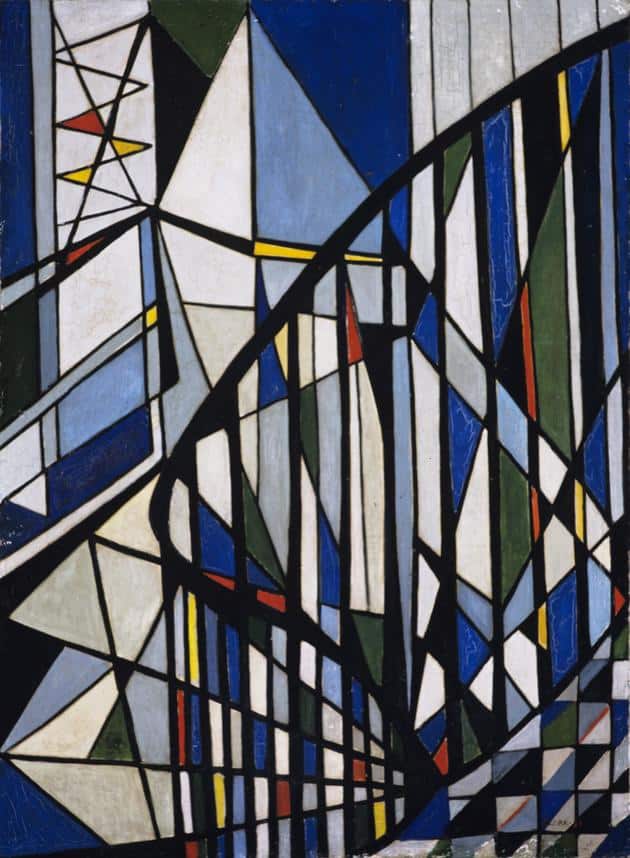

Painting has always been a body. That is what it is in Pliny’s story, where a substitute for the body—its shadow—receives a kind of deferred touch or caress, enacted by drawing, in preparation for its imminent departure and absence. The result falls into the register of the “inframince.” Surprisingly, anachronistically, this is why Pliny’s account is so relevant to Clark. Painting has been a body positioned by the traditions of our culture to harbor other bodies, which it represents, offers up, in different keys—the key of mimesis, or of absence, or, to use a word dear to Clark, of nostalgia. But painting doesn’t hold these bodies as a womb does, growing, swelling, and then spitting them into being, into falling to earth; rather— and this has been so since antiquity—it acts as a place that shelters and preserves these bodies and their actions, whether real or symbolic, historical or fictional. Hence the importance for us of Clark’s early works in which images, forms, and figures seem to go beyond abstraction, whether by force or voluntarily, to represent places, coordinates, interior spaces, and planes with edges, surfaces, and architectures.
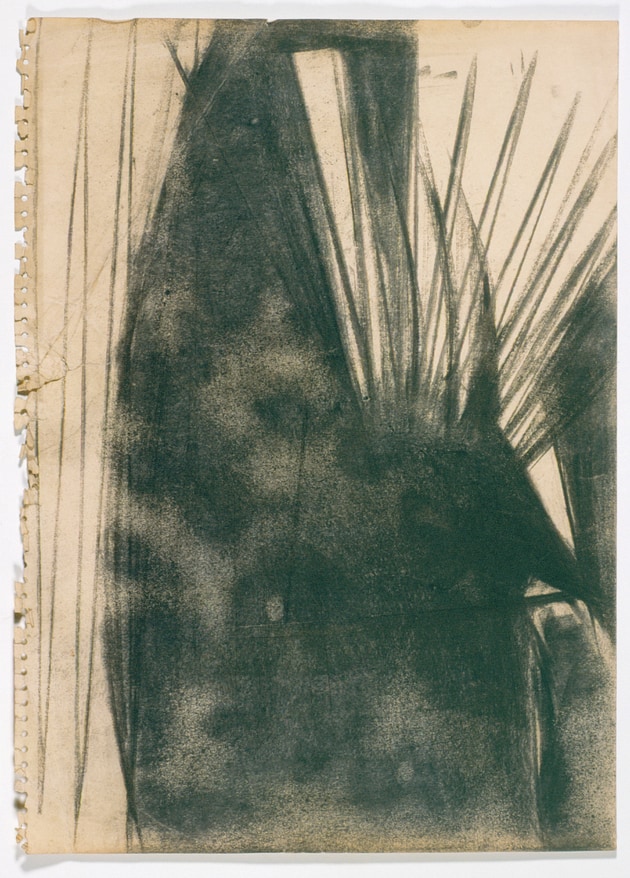
It is in this sense that Paulo Herkenhoff has written of staircases in some of Clark’s early works.2Paulo Herkenhoff, “Lygia Clark,” in Lygia Clark (Barcelona), p. 36. Herkenhoff links these staircases to Clark’s training in the late 1940s with the landscape architect Roberto Burle Marx, who was originally a painter and would later come to approach architecture as a pictorial field. As Herkenhoff notes, Clark went straight from her studies with Burle Marx in Rio de Janeiro to studies with Fernand Léger in Paris, and this at a moment when Léger was thinking as an architect, if I may go that far—at any rate when he was focusing on projects that attempted the modernist utopia of a fusion between art and architecture. To this end he developed such concepts as parois vivantes (living walls), rectangles habitables (inhabitable rectangles), and rectangles élastiques (elastic rectangles), concepts that, as Herkenhoff writes, would be important to critics thinking through Clark’s later work.3See ibid., p. 37.
A careful study of the architectural aspect traceable in Clark’s early works and fully visible in her later ones might help us to move beyond a reading of those works as two-dimensional paintings emancipated into bodies or things. In fact that reading comes to us filtered through multiple forgettings, beginning, as I have said, in its failure to recognize itself as the echo of an ancient voice. More significantly, it further asks us to forget that painting has always been a matter of volume, of density—has always been a three-dimensional form (a two-dimensional form being a physical impossibility). When we say that painting is two-dimensional—and even more when we see it that way—we surrender our gaze and our speech to a convention of blindness: we decide not to see the work’s body or thickness, which exists even when limited to the inframince dimension of paint. Finally, and perhaps most importantly for an understanding of Clark’s work insofar as it originates in architectural thinking, that convention itself relies on a forgetting, both structural and historical, of a foundational fact about Western painting: that is, that the first scientific treatise on painting, the first manifestation of painting as analytic thought, was Leon Battista Alberti’s De Pictura, of 1435—the work not of a painter but of an architect.
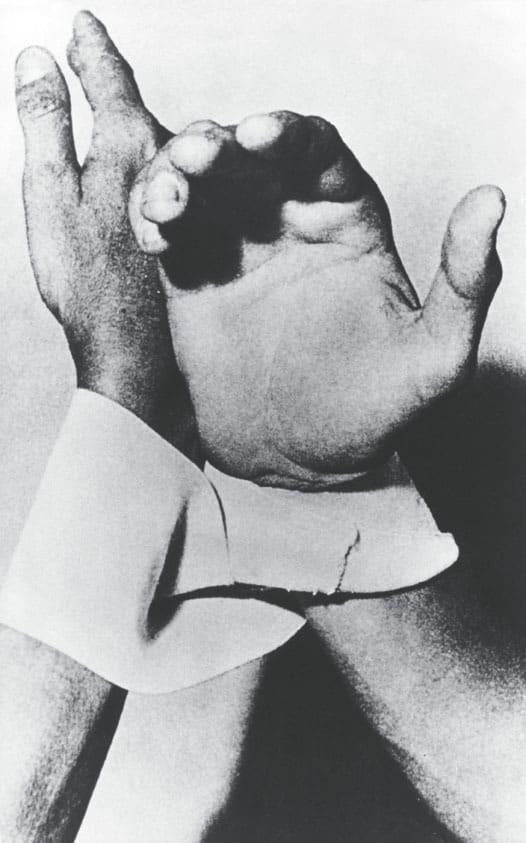
The first pages of Alberti’s book address something that we might today call “topology,” in that in reflecting on the representation of physical bodies, he does so in terms of coordinates, places, locations in space. This explains the well-known assertion with which he begins his treatise, “Parlo come pittore,” “I speak as a painter”: he states up front, in other words, that although he has borrowed some of his concepts from mathematics, he is speaking not as a mathematician but as a painter, for mathematics makes abstractions out of material dimensions and physical things, while a painter, who “wants things to be capable of being seen,” must use a “più grassa Minerva”—a heavier Minerva, the Roman goddess of art- makers and artisans.4Leon Battista Alberti, De Pictura, 1435. My translation follows the French translation by Jean Louis Schefer inDe la peinture (De Pictura) (Paris: Macula, 1992), which retains Alberti’s Italian phrase “più grassa Minerva” (or, in the Latin of the first edition, Minerva scribendo utemur). Some English From Pliny to Alberti to Clark—the “longue durée” of our problem—the reality of painting seems to be translated into two opposing dimensions. One might be characterized as “inframince,” or “ultra-thin,” almost incorporeal, a moment of encounter between two bodies or hands, like a line drawing the shape of a shadow on the wall. The other is the “più grassa Minerva,” or “heavier Minerva,” invoked by Alberti: a body, capable of growth, of swelling, of inflammation, of presenting itself, of finding itself, of fusing with another body, but also of separating itself or absenting itself, like the lover of Butades’s daughter.
It should not seem strange, then, that Clark might from early on have approached painting as architecture, as a science of topology, an operator of place—of coordinates, shelters, homes. I don’t mean that she thought of painting as a form of architecture but that she thought of painting’s conditions of possibility in architectural terms, and that her sense of painting was fundamentally topological. This kind of thinking began early, around 1954 or 1955, in works centering on her discovery of what she called the “organic line.” Significantly, her first formal articulation of this concept appears in a lecture she gave at an architectural school, the Escola Nacional de Arquitetura, in Belo Horizonte, her hometown, in 1956. So we can say that she initiated her greatest contribution to modernist abstraction by thinking—and perhaps also painting—as if she were an architect. If the first theorist of painting, the architect Alberti, claimed to have spoken as a painter, the painter Clark, at the other end of that history, claimed to have spoken as an architect. “The artist,” Clark said in her lecture in Belo Horizonte,
might also investigate by way of lines I’ll call “organic,” lines that function as doors, as connections among materials, as tissues, etc., in order to modulate an entire surface….The visual problem is simply the valuation or devaluation of that line. When I grounded my thinking in this observation, I was able to locate a relationship between the line as I explore it in my paintings and functional architectural lines.5Clark, “Maquete para interior,” Diário de Minas (Belo Horizonte), January 27, 1957, Eng. trans. as “Conference Given in the Belo Horizonte National School of Architecture in 1956” in Lygia Clark (Barcelona), a translation reprinted in the present volume under the title “Lecture at the Escola Nacional de Arquitetura, Belo Horizonte, Fall 1956,” p. 54.
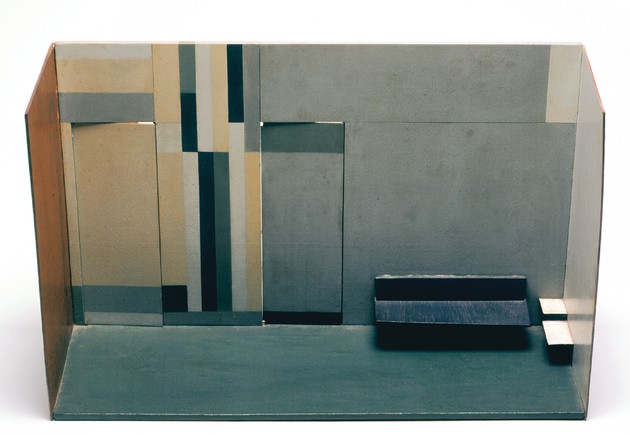
If anything can be called a painting in a state of inflammation, of growth—if anything grows and densifies in Clark’s paintings between 1948 and the 1960s—it does not end up falling to the floor like a critter but rather takes the shape of a place, the place of a place, a coordinate in space, whether that space be imaginary, virtual, or potential. It becomes something that finally resembles less a critter than a building or a house—a place that someone might inhabit, and where he or she might interact with other bodies. We all recognize that Clark’s work after 1965 has to do with the body inhabiting coordinates, and more significantly with the possibility that it might interact with others. Clark herself, summarizing her process in the 1970s, argued that Mondrian, in doing away with representational space in painting, left as a legacy the exclusion of subject matter that wasn’t in some way “body to body,” along with a need for artists to express themselves through “a living organism.”6Clark, fragment, c. 1970, Archives of the Associação Cultural “O Mundo de Lygia Clark.”
It is crucial, then, to understand the pictorial origin of Clark’s work, the archaeology of painting buried within it, its derivation from an archē of painting. What that might be, as Giorgio Agamben writes of the archē in general, we cannot know in terms that are “locatable in a chronology (even with as large a frame as prehistory); instead, it is an operative force within history, like the Indo-European words expressing a system of connections between historically accessible languages, or the child of psychoanalysis exerting an active force within the psychic life of the adult, or the big bang, which is supposed to have given rise to the universe but which continues to send toward us its fossil radiation.”7Agamben, The Signature of All Things, p. 110. The archē of painting from which Clark’s work emerges is more than an initial state that can be superseded, and the term does not mean the artist’s earliest paintings, given that, like the rest of her work, they emerged directly from that archè themselves, if in a far more radical and complex way than Gullar’s account allows. But even if the archē is something “which is supposed to have taken place but which cannot be hypostatized in a chronological event,” Agamben writes, it “is able to guarantee the intelligibility of historical phenomena, ‘saving’ them archaeologically in a future anterior in the understanding not of an unverifiable origin but of its finite and untotalizable history.”8Ibid.
Perhaps Clark had something like this in mind when, in 1960, having finished herContra relevos and Casulos series, she spoke of a vision that would not be optical but rather would relate to a nonimmediate manner of feeling, “in the profound sense that we do not know where our origin is.”9Clark, “The Empty-Full,” p. 159. Here I would like to propose an alternative to the interpretation of Clark’s process as an address of formal problems unfolding into objects. That is, to a narrative centered on the transformation of two-dimensional figures into things I would like to oppose an interrogation that instead asks what forms do, what forms transform—that examines neither their figurative presence nor their eventual metamorphosis, but rather their capacity to activate their field of inscription through topological “shifts”—like the gearshifts of cars—and this, of course, within painting.
The idea of the shift is key to this hypothesis, since a shift is what we use to make a change, from one gear to the next, from one structural mode to another. The lines Clark traced in her early works were shifts, and her entire repertoire of works showing modulated spaces and surfaces, or showing planes within modulated spaces and surfaces, depends on an understanding of the line as a shift. A hinge— that is, the mechanism that allows the Bichos to be folded—is a mechanical kind of shift. And in light of the importance of such shifts, Clark’s work reveals itself as entirely determined by its performativity—and all this, as well, within painting, as a work destined to have and produce concrete effects.

Undoubtedly it was the experience of Caminhando, in which Clark invited people to cut a Möbius strip to the thinnest width possible, that finally offered her the possibility of seeing her work as action—to understand that its temporality could only be performative, and that this had been the case from the start. Participants were asked to cut lengthways along a paper Möbius strip without splitting it into two. When the scissors returned to where they had begun, the participants had to choose whether to move to the right or the left of the existing cut, and then keep cutting. This choice—the idea of decision-making—is central in Clark’s reflections on this experience:
This idea of choice is decisive—within it lies the experiment’s only meaning. The work is its enactment. As the strip is cut, it gets finer and is unfolded in intertwinings. In the end, the path is so narrow that it can no longer be cut. It is the end of the shortcut.
[...]
Each Caminhando is an immanent reality that is revealed in its totality during the period of the spectator-creator’s expression.
Initially, the Caminhando is only a potential. You and it will form a reality that will be unique, total, existential. No separation between subject-object. It is a body-to-body affair, a fusion. The different responses will come out of your choice.
The dualist relationship between man and Bicho, which characterized the previous experiences, is succeeded by a new type of fusion. In being the work and the act of making the work, you and it become completely inseparable.
There is only one type of duration: the act. The act is what produces the Caminhando. Nothing exists before it and nothing after.10Clark, “Caminhando,” Livro-obra (Rio de Janeiro, 1983), Eng. trans. as “Walking” in Lygia Clark (Barcelona), a translation reprinted in the present volume under the title “Caminhando,” pp. 160–61.
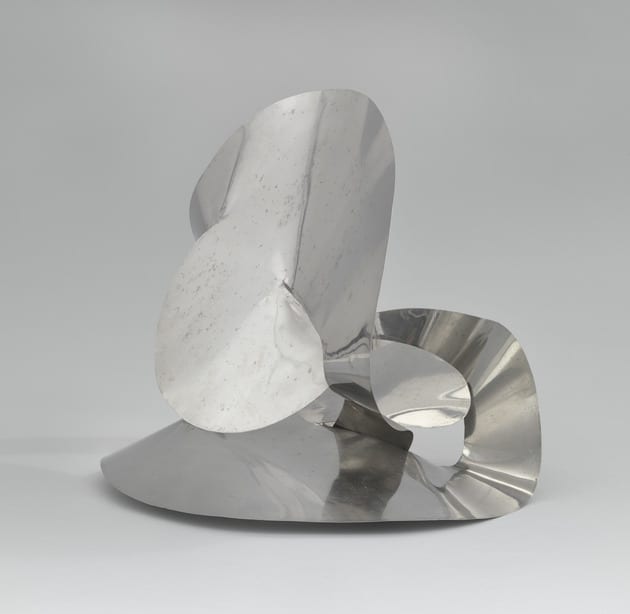
The Caminhando opened the possibility of an “active” dimension in the work. It also allowed Clark to close the chapter on the Bichos with a key piece, O dentro é o for a (The inside is the outside, 1963). Unlike the Bichos, O dentro é o for a is not strictly foldable, and it contains no hinges: the work is a Möbius strip, this time made in steel, to be held in one’s arms, as in a well-known photograph of Clark. In a note typed on November 1, 1963, in a mood of spiritual and physical exultation just before a return to Paris, a state of aesthetic reflection and of erotic and disturbing dreams, Clark asserts,
Now I perceive the whole meaning of O dentro é o for a. I find that only now am I beginning to understand something….With total humility I recognize that my perception is minimal and I am beginning really only now, and my perception is minimal because it’s the beginning. How could I have thought of myself for so long as great, as if I had discovered a world? The awareness that in this work space is an affective space is the first time I really begin to create a living organism, like a being, and this was truly the reason for my crisis and also the awareness that until now I hadn’t perceived anything, not anything at all.11Clark, typed note, November 1, 1963, Archives of the Associação Cultural “O Mundo de Lygia Clark.”
This deferred, delayed, or “après-coup”12See Jean Laplanche, Problématiques VI. L’Après-coup (Paris: Presses Universitaires de France, 2006), pp. 76–84. access to “awareness” of O dentro é o for a had origins in the past, being inscribed—if specifically as a potential—in the formal decisions that had informed all of Clark’s work since the early 1950s, when she had created architectural models with open spaces that would contaminate inside with outside and would signal the mechanisms, the shifts, that she would call “organic lines” in her 1956 lecture in Belo Horizonte. It is crucial, however, to underscore—as Clark does in her typewritten note—the affective quality of space in O dentro é o for a: this was a sculptural form whose condition of possibility originated in action, the action of Caminhando. But in what sense might a form, an abstract structure, be affective? How do we affect it or how does it affect us? What did the affective space of O dentro é o for a do? What did it transform in us or in reality? To investigate this affective—that is, performative—dimension of the work, and how Clark moved away from rigorous formal exploration, we must summarize the two great inventions—or discoveries—that propelled her visual thinking, and that took the form of “lines.”
Caminhando resulted from Clark’s fascination with the Möbius strip. It was not just the Möbius form that intrigued her but also its implications, what that form does— its capacity to determine a spatial coordinate in which there is no discontinuity between interior and exterior, inside and outside. The Möbius strip is a line, but one that no longer functions to separate things, beings, or fields. This afunctional line is logically different, even opposed, to the organic line, which Clark had called a “functional line” in her 1956 lecture.
Clark discovered the organic line by projecting a series of questions, architectural in nature, onto her assimilation of the legacy of Mondrian. She identified it first in architectural tools such as doors—transitional devices capable of modulating space—and in connective fusions between materials and in the stitches of textiles. For her, architecture and painting were mediating terms between the idea of an absolutely continuous field—an ideal surface or space, of a kind that might be called by an ancient philosophical name, khôra—and the inexorable discontinuity of the reality within which our life takes place. Clark’s titles for her works of the late 1950s—Superfícies moduladas (Modulated surfaces), Planos em superfícies moduladas, Espaços modulados (Modulated spaces)—are clear signs that she had come to see painting as a functional device for modulating spaces and surfaces through their own topological discontinuity—through their discontinuous shifts.
The organic line, then, is not strictly a line, at least not a graphic line, but neither is it a line in Alberti’s sense: “points…joined without interruption, according to a sequence.”13Alberti, On Painting: A New Translation and Critical Edition, trans. Rocco Sinisgalli (Cambridge and New York: Cambridge University Press, 2011), p. 23. The organic line is a caesura, a break, a fold—a fissure, an absence, a line in absentia. As a negative presence, a nonline, a minus-line or line-minus, it works as an incision between materials—something that, in slicing a surface, reveals that surface’s density and materiality, dividing it into two fields or bodies, separating them and in the process indexing the infinite drama of continuity and discontinuity that constitutes space as a site and coordinate of plurality.
Clearly Clark was fascinated by the potential for plurality latent within every existing thing. She tried to capture this idea in works such as the Composição of 1953 that prefigures the Bichos, and in most of her foldable, transformable sculptures of the early 1960s. We might say that the Bichos turn the fissure or breaking point between two surfaces into a hinge, an agent of discontinuity within a given unity, and that as such they point toward something that occurs in the interval itself, in the exact coordinate between the limits at which things transform into other things, fields into other fields, bodies into other bodies. How a unity becomes a plurality, how the multiple unfolds from the singular: these issues are crucial in mathematics and topology, in metaphysics and ethics. They ask us to address the possibility of thought centering on the links between self and other, us and them. Clark seems to have located this question at the heart of her 1967 workO eu e o tu. Roupa-corpo-roupa (The I and the you. Clothing-body-clothing), which implies the performative enactment of a body-to-body linking, as well as in most of the sensorial and relational works that she began to produce in 1965.
All of this points to the thinking that may have led Clark to the “negative” concept of the organic line—a nonline, an absence of line, yet a line whose negativity in no way threatens its functionality. We might consider, however, that Caminhandoimplies a different, even opposite typology: as the paper strip is divided until “it can no longer be cut,” as Clark said, the line that ensues may be very thin—inframince—but it is materially present. It is real, literally a part of reality, not something cut away but something remaining, neither a graphic line nor an empty space but a material presence, or, better, the inframince residue of paper in the form of a line: empty-full.
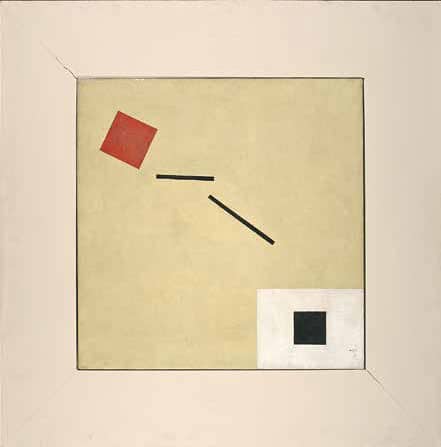
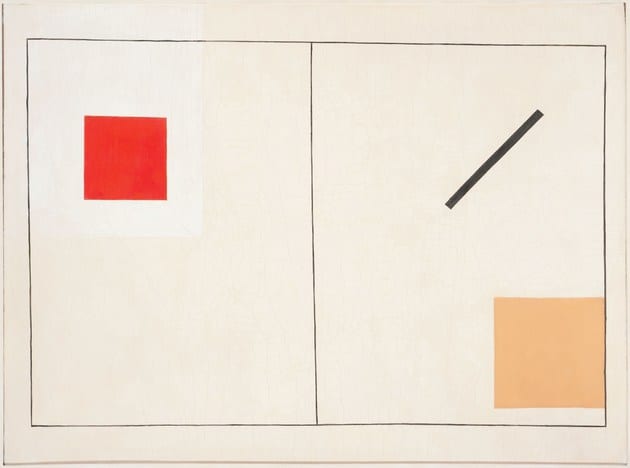
We must remember that this line is a residue, the remainder or residue of an action, and we must also remember that Caminhando is that action. This work then implies something like a reinvention of the line. In speaking of her “discovery” of the organic line—Descoberta da linha orgânica, runs the title of a pair of key works from 1954—Clark had implied that its existence preceded its appearance in art, that it was not something voluntarily produced within art but a fixed, determining presence in reality, just as all discontinuity is present among us and in the world. The line produced by Caminhando, on the other hand, is a positive—though residual—consequence of an action: an object-line, a thing in the form of a line, a body that is a line—a “line-plus,” then, in contrast to the absent line, the “line- minus” or fissure that is the organic line. Caminhando’s line does not exist a priori in the world, like the organic line; instead it takes place, it occurs, it comes to pass, in infra-thin or inframince form, when the action of cutting the paper prevents us from continuing—when “the path is so narrow that it can no longer be cut. It is the end of the shortcut.”
This alone would be enough to make Caminhando pivotal. In a sense, the work implies a mnemonic emergence, the return of a deep memory—a concept of the line that Western art seems (again) to have left to oblivion. As before, the source lies in Pliny, in a famous story, set in the fourth century b.c., that like Caminhandoimplies a questioning of the idea of individual authorship. In recalling this story we must remember the question that led us here: what role does an archaeology ofpainting play in the work Clark produced beyond painting? How does the archē of painting in her works (even in those that are clearly metapictorial) broadcast its own “fossil radiation”?14Agamben, The Signature of All Things, p. 110.
Pliny describes a kind of contest between two of the most renowned artists of antiquity. Apelles has just arrived in Rhodes, intending to see the work of Protogenes, which he knows only by its reputation. In the artist’s studio, instead of the artist himself, Apelles finds an old woman and “a panel of considerable size on the easel.” Picking up a brush, he draws “in color across the panel an extremely fine line,” which the woman is to show to Protogenes as a sign of who his visitor was. On returning, Protogenes recognizes the mastery of Apelles’s line, but draws on top of it, dividing it, “a still finer line,” which he asks the old woman to show to Apelles as his own signature. Apelles returns, sees that Protogenes has challenged him, and draws a third line atop the second one, Pliny tells us, “leaving no room for any further display of minute work.”15Pliny the Elder, Natural History, XXXV, XXXVI, p. 323.
I find in this scene the archaeology of an alternative concept of the line, a concept that Western art has forgotten. The question is, can a line be made that is free of any visual regime determined by visible terms—by the presence of edges, or of discontinuities or interruptions—a line that does not divide, that neither contains nor surrounds, a residual line that determines neither the end of one thing nor the beginning of another, a free, afunctional line that exists in space as the happy remainder of an action with no end but itself? It’s easy to understand Clark’s joy, in November 1963, when she felt that with Caminhando she had arrived for the first time at this indeterminable and undecidable place, this remote and also purely potential space: “If I were to stop making art after this,” she wrote, “I think it wouldn’t matter at all, because I’ve completely lost the sensation of ‘loss in relation to time.’ It seems that the spaces inside me are broader and my breath is hardier.”16Clark, fragment, November 11, 1963. Archives of the Associação Cultural “O Mundo de Lygia Clark.”
Clark had come to produce, with a very graceful touch, a line that was like a pure act, in the sense not just of being one with the act and the person that had produced it but of actually, continuously being, of not ceasing to be. If it is possible to assign verb qualities to lines, this was a gerundive line rather than a transitive one, a line that had no beginning and no end, a line that went nowhere and came from nowhere, a line that signaled an existential possibility, a provisional eternity where instead of separation and distance—the abyss—between and within bodies lay continuity. This line that could go no thinner, that could be divided no further, is the line that Clark “reinvented” in Caminhando: an effective and affective line, the zero signifier of an unattainable excess of signification.
The abyssal organic line and the nondividing Caminhando line—how does the one relate to the other? How might we move from the one to the other—from the organic line that is functional, that contains and divides, distinguishes and distances, defines and marks coordinates, to this line that has no set function, that floats free in the air, yet nonetheless manifests as an action? How might we consider these two lines as diverging or dialectical manifestations of a single problem—that is, the issue that seems ultimately to have driven all of Clark’s art, from the topology implicit in her earliest works to the drama of intersubjectivity that unfolds in her final ones?
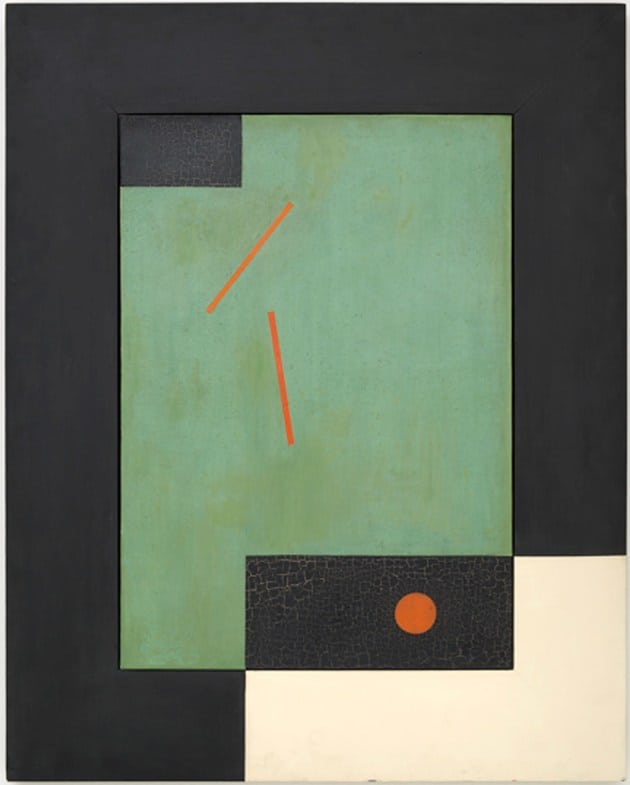
The process by which Clark discovered the organic line was both pragmatic and fundamentally inductive. She began with inferences from a series of decisions and actions to do with the surface of the painting, where she observed “two lines that appeared when there were two planes of the same color, next to one another, which then disappeared when the colors were contrasting….I made large paintings
with tremendous frames in which I negotiated with this line, depending on the color of the canvas in relation to the frame itself.”17Clark, fragment, n.d. Archives of the Associação Cultural “O Mundo de Lygia Clark.” Here the organic line appears as a linear incision, a break in the continuity of the painting—and as such inducing phenomena of discontinuity in the real world. Piercing the density of the painting, it pierces the density of the world’s body. Hence, Descoberta da linha orgânica(Discovery of the organic line). Clark had “discovered” something that already existed: “in my naiveté and provincialism I didn’t realize that it was simply a line that is a space,” she wrote.18Ibid. This line, previously unknown to her, could then become a general law of reality, one she could induce by observing certain concrete, known occurrences. As a line of separation, the organic line is theinframince void that affects us in perpetuity, separating and dispersing us, making us discontinuous and strange, and engendering in us the need to seek a suture, a solution, a poultice, a fusion.
The discovery of the organic line would lead Clark to the conviction that things exist in an abyss of separation. Whether in the accidents of their present or in the phantasm of their engendering and conception, they do not match, like uneven, inescapably fractured tectonic plates. In her lecture at the Escola Nacional de Arquitetura, Clark remarked, “I then began to work on the ‘Superfícies moduladas,’ made in plywood previously cut to various precalculated sizes, trying to integrate segments from that real line.”19Clark, “Lecture at the Escola Nacional de Arquitetura, Belo Horizonte, Fall 1956,” p. 54. “That real line”: the organic line is real, is a space, is a line that exists in reality rather than being introduced into it through creativity or invention. And since it is part of reality, Clark’s works investigating or manifesting it are to a certain degree representational, though not mimetic: the organic line is a representation in the word’s strictest and most logical sense, a new, supplementary presentation of a real line, a line that exists in reality.
A different phenomenon, deductive rather than inductive, occurs in Caminhando. In cutting a Möbius strip until it is infra-thin, until to keep cutting it is impossible, we can deduce—corporeally, as the result of a finite sequence of repetitions—the existence of another line, present in the work’s residually multiplying mass of paper, which settles like the mute thought of the act that constitutes it. The line inCaminhando, while no less real than the organic line, is unlike that line in that it did not exist previously in the world. It might exist by analogy, and it exists in part in Pliny’s anecdote—one more of the archaeological figures of painting to which our discussion of Clark has led us—but this line is not a discovery; rather, it is a residue, to which the cutting of the paper leads in the way that fluids flow to their destinations. It is not a transitional, functional line, a line in the organic body of things—as might be implied by the very name of the organic line—but an autonomous, immanent line, not necessarily inorganic but free of subordination to or dependence on an organism or other source of support. It is an afunctional, a priori line to which we return, once we have arrived at it, as if to an undefined place where it exists as a potential, and from which, therefore, it always precedes us without ever having taken place among things.
I think of the organic line as like a wound—the wound of the division that prevents us from becoming one single, continuous reality—and of the line in Caminhando as like a cure. Clark’s happiness in arriving at the second of these lines is justified in light of a life and a practice, from 1948 to 1963, in which she unceasingly diagnosed the forms and signatures of the limiting force that always divides human existence. We might say that the line in Caminhando resolves the axiom of the abyss. Clark can only have experienced it as an arrival at an inspiring, joyful terrain.
This is the second section of an essay by Luis Pérez-Oramas on the Brazilian artist Lygia Clark, excerpted from the exhibition catalog Lygia Clark: The Abandonment Of Art, 1948-1988, available at the MoMA bookstore. Read the first section here. The third section will be released in June 2018.
translations instead try to express the “meaning” of Alberti’s metaphor—e.g., “Since we wish the object to be seen, we will use a more sensate wisdom” (Alberti,On Painting, trans. John R. Spencer [New Haven and London: Yale University Press, 1956], 1:43)—but this is an interpretation rather than a translation. The goddess Minerva was not only the patron of art-makers and artisans but also the embodiment of wisdom. In referring to a more “grassa Minerva” Alberti was simply expressing the need for a practical intelligence, an understanding of physical facts, in thinking about visual arts such as painting.
This is the second section of a three-part essay by Luis Pérez-Oramas on the Brazilian artist Lygia Clark, excerpted from the exhibition catalog Lygia Clark: The Abandonment Of Art, 1948-1988, available at the MoMA bookstore. Read the first section here and the third here.
- 1See Pierre Aubenque, Le Problème de l’être chez Aristote, 1962 (reprint ed. Paris: Presses Universitaires de France, 1991), pp. 460–72.
- 2Paulo Herkenhoff, “Lygia Clark,” in Lygia Clark (Barcelona), p. 36.
- 3See ibid., p. 37.
- 4Leon Battista Alberti, De Pictura, 1435. My translation follows the French translation by Jean Louis Schefer inDe la peinture (De Pictura) (Paris: Macula, 1992), which retains Alberti’s Italian phrase “più grassa Minerva” (or, in the Latin of the first edition, Minerva scribendo utemur). Some English
- 5Clark, “Maquete para interior,” Diário de Minas (Belo Horizonte), January 27, 1957, Eng. trans. as “Conference Given in the Belo Horizonte National School of Architecture in 1956” in Lygia Clark (Barcelona), a translation reprinted in the present volume under the title “Lecture at the Escola Nacional de Arquitetura, Belo Horizonte, Fall 1956,” p. 54.
- 6Clark, fragment, c. 1970, Archives of the Associação Cultural “O Mundo de Lygia Clark.”
- 7Agamben, The Signature of All Things, p. 110.
- 8Ibid.
- 9Clark, “The Empty-Full,” p. 159.
- 10Clark, “Caminhando,” Livro-obra (Rio de Janeiro, 1983), Eng. trans. as “Walking” in Lygia Clark (Barcelona), a translation reprinted in the present volume under the title “Caminhando,” pp. 160–61.
- 11Clark, typed note, November 1, 1963, Archives of the Associação Cultural “O Mundo de Lygia Clark.”
- 12See Jean Laplanche, Problématiques VI. L’Après-coup (Paris: Presses Universitaires de France, 2006), pp. 76–84.
- 13Alberti, On Painting: A New Translation and Critical Edition, trans. Rocco Sinisgalli (Cambridge and New York: Cambridge University Press, 2011), p. 23.
- 14Agamben, The Signature of All Things, p. 110.
- 15Pliny the Elder, Natural History, XXXV, XXXVI, p. 323.
- 16Clark, fragment, November 11, 1963. Archives of the Associação Cultural “O Mundo de Lygia Clark.”
- 17Clark, fragment, n.d. Archives of the Associação Cultural “O Mundo de Lygia Clark.”
- 18Ibid.
- 19Clark, “Lecture at the Escola Nacional de Arquitetura, Belo Horizonte, Fall 1956,” p. 54.
